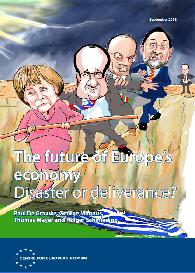Whyte, P. and Tilford, S. eds., (2013), The future of Europe’s economy: Disaster or deliverance?, Center for European Reform, 18 Σεπτεμβρίου.
The CER invited four leading economists to predict what the European economy will look like in 2020. Their answers differ sharply. Paul De Grauwe fears for the future because the eurozone’s creditor countries have succeeded in loading nearly all of the cost of eurozone adjustment onto the debtor nations. The creditors need to do more to stimulate demand in their economies and the debts of the eurozone’s hard-hit members must be cut. For George Magnus, rapid population ageing, weak productivity and a divided eurozone have collided to produce the most significant threats to Europe’s economy and the legitimacy of its political institutions since the 1930s. Thomas Mayer suspects that fiscal discipline in the eurozone will crumble and the ECB will monetise debt, leading to higher inflation in northern Europe. The result will be stand-off and the launch of a German-led parallel currency to compete with the euro. Holger Schmieding is more optimistic. He believes that by 2020 the countries that are today in difficulties will be reaping the rewards of structural reform and that the eurozone will be stable.
Σχετικές Αναρτήσεις
- Scenario Team Eurozone 2020, (2013), “Future Scenarios for the Eurozone: 15 Perspectives on the Euro Crisis”, Friedrich Ebert Stiftung, Μάρτιος.
- Triandafyllidou, Ann., Gropas, R., & Kouki, H., (ed.) (2013), The Greek Crisis and European Modernity, Palgrave Macmillan.
- O’Sullivan, Michael, (2012), ‘Does an Austere Europe have a future?’, Ελληνική Επιθεώρηση Πολιτικής Επιστήμης, Τεύχος 39, Μάιος-Νοέμβριος.




